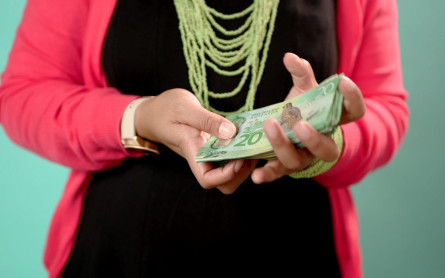Budgeting

Planning & budgeting
Saving & investing
KiwiSaver
Tackling debt
Protecting wealth
Retirement
Home buying
Life events
Setting goals
Money tracking
Plan your spending with a budget
Getting advice
Studying
Get better with money
What pūtea beliefs do you have?
How to save your money
How to start investing
Find a financial adviser to help you invest
Your investment profile
Compound interest
Net worth
Types of investments
Term deposits
Bonds
Investment funds
Shares
Property investment
How KiwiSaver works and why it's worth joining
How to pick the right KiwiSaver fund
Make the most of KiwiSaver and grow your balance
How KiwiSaver can help you get into your first home
Applying for a KiwiSaver hardship withdrawal
How to use buy now pay later
Before borrowing
How to get out of debt quickly
Credit reports
Know your rights
Pros and cons of debt consolidation
Credit cards
Car loans
Personal loans
Hire purchase
Student loans
Getting a fine
What happens if I start to struggle with moni?
How to protect yourself from fraud and being scammed
About insurance
Insurance types
Insuring ourselves
Wills
Enduring powers of attorney
Family trusts
Insuring our homes
Losing a partner
Redundancy
Serious diagnosis
How to cope with the aftermath of fraud
Separation
About NZ Super
This year's NZ Super rates
When you’re thinking of living in a retirement village
How to plan, save and invest for retirement
Manage your money in retirement
Find housing options in retirement
Planning & budgeting
Saving & investing
KiwiSaver
Tackling debt
Protecting wealth
Retirement
Home buying
Budgeting
Money tips
Goals
Matariki
Budgeting
KiwiSaver
Money tips
Budgeting
Resources
Help with the cost of living
Just wondering
In need of financial help
Booklets
Glossary
Videos
Money Month events
Blogs
View all
15 April 2024
Reading time: 3 minutes
Posted
by
Tom Hartmann
, 1 Comments

For every dollar you put into KiwiSaver, the government puts in 50 cents – up to $521 each year. Here’s how not to miss out:
You’re on track to get your full boost from the government if you’re an employee earning at least $34,762 a year (before tax) and have been contributing at least the minimum 3% into KiwiSaver.
No need to do anything – just watch $521 drop into your account in late July or August. Done!
If this is not you, however, move on to step 2.
If you are not an employee or you earn less, you’ll need to check your contributions. In order to get that full boost from the government, you need to have paid in at least $1,043 this year.
How much have you put in? The easiest way to find out is to ask your KiwiSaver provider – here’s a contact list. (If you’re not sure who your provider is, you can call 0800 KIWISAVER to find out.)
Your KiwiSaver provider will be able to tell you whether you’ve contributed $1,043 this year. If you haven’t yet, there’s still in time to top up your account by mid-June and get the full $521.
How much do you need to put in to get across the line? Your provider will know.
During the weeks ahead, before June runs out, make arrangements with your KiwiSaver provider to top up your account. You may want to set up an automatic payment each time you’re paid, or just pop in a lump sum when you’re ready. Aim to have at least $1,043 in by mid-June.
Even if you can’t get the full $1,043 into your KiwiSaver by mid-June, it’s still worth paying in as much as you can – the government will match each dollar with 50 cents. So even putting in $300 nets you $150, for example.
If you typically contribute less than $1,043 per year – and I'm thinking of all the self-employed, stay-at-home parents, part-time and casual workers out there – here's how to set yourself up to get the government contribution next year.
The KiwiSaver year runs from July to June. To make sure you don’t get caught short next year, set yourself up to contribute at least $20 a week, starting this July.
Again, automatic payments make it easy to set and forget. When next year rolls around, that government money will flow in without you needing to check anything.
Over your entire KiwiSaver experience, the government contribution could be worth as much as $36,000* – a real boost!
*If you put in $1,043 each year from the age of 18 until the age of 65, the government will have given you $24,507. If you get an average return of 5% per annum on this, you’d have more than $36,500 by the time you access it (even after fees, tax and inflation). That's on top of your own contributions, your employer contributions and any other investment returns you've received.
My Money Sorted: Gordon
1 Comment
Guided by Matariki, it’s the perfect time to think ahead
1 Comment
My Money Sorted: Jaelyn
1 Comment
5 steps to get your $521
1 Comment
Who’s teaching your daughter (or niece, or granddaughter) about money?
1 Comment
My Money Sorted: Hilary Barry
3 Comments

Use verification code from your authenticator app. How to use authenticator apps.
Code is invalid. Please try again
Don't have an account? Sign up
Or log in with our social media platforms


A Sorted account gives you a personal dashboard where you can save your tools, track your progress and you'll also receive helpful money tips and guidance straight to your inbox.
Or sign up with our social media platforms



Comments (1)
Comments
27 May 20
Angela Pere Pomare
What happens to my kiwi saver when I die? Where do my funds go?
No one has commented on this page yet.
RSS feed for comments on this page | RSS feed for all comments